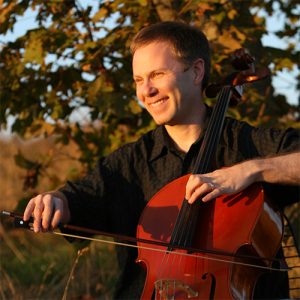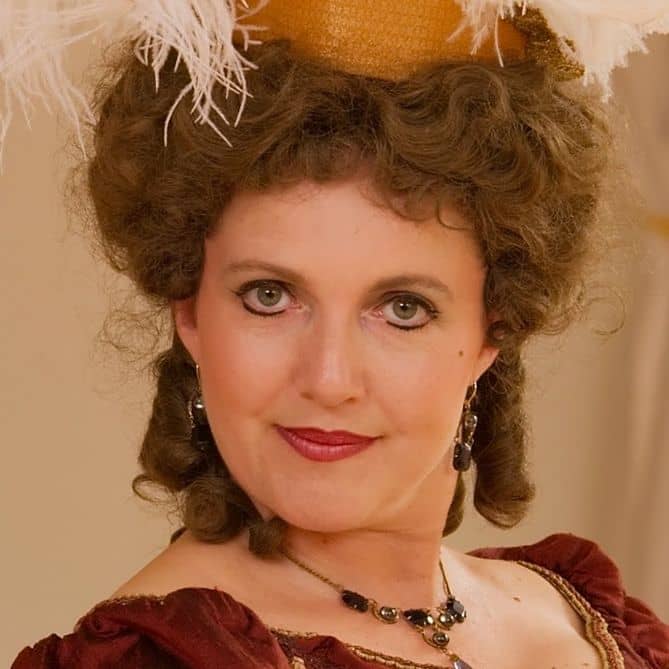
Baroque Dance and the Bach Cello Suites (November, 2002)
Tim Janof
by Tim Janof
A statement made by Nathaniel Rosen about the Bach Cello Suites has been bugging me for years:
- “People often talk about the notion that these pieces are dance movements. They’re not dance movements! They are works for unaccompanied cello which have, with the exception of the Preludes, titles of dance movements.” 1
Having never seen a Baroque dance, how could I know if this statement is correct? I’ve read a couple of books on Baroque dance, but, like learning to play the cello, a one can’t get an intuitive sense of such a kinesthetic subject from a book.
As luck would have it, I recently discovered that Anna Mansbridge, a Baroque dance specialist, had moved to my hometown, Seattle. She hails from the United Kingdom, where she studied for many years with teachers foremost in the dance profession. She holds degrees from Bedford College (UK) and Mills College in California. She has taught and performed Baroque dance in the United Kingdom and other parts of Europe, including Norway, Sweden, and Croatia. A resident of Seattle since 1998, she returns to Europe regularly to stage operas and teach early music courses. In 1995 she co-founded Footwork OffLimits, a dance company that blends early and modern dance genres. In Seattle, where she teaches Baroque dance, she is the artistic director of Seattle Early Dance and an artist-in-residence for the Washington State Arts Commission (2001-2003). I could finally pose my many questions to a Baroque dance specialist and watch her dance allemandes, courantes, bourrées, etc.
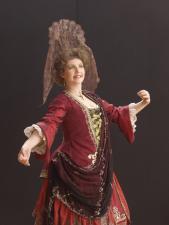
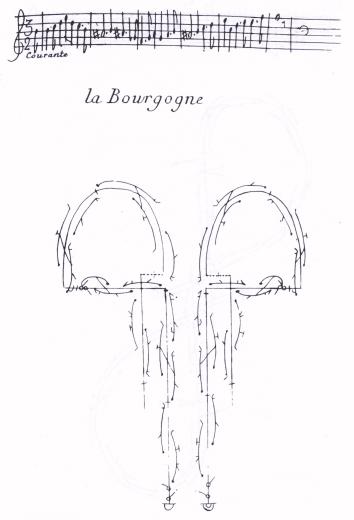
Choreography by Louis Pécour, notated by Raoul Auger Feuillet. 2
It seems that steadiness of pulse is one point of contention in the dance world, and this goes back to the Baroque era, if not before. Dance Master Kellom Tomlinson wrote in 1735,
- “it may perhaps be objected and at first View with great Show of Reason, that the Time in Dancing is various and liable to be changed to faster or slower, according to the Performer’s Fancy” [italics by Kellom Tomlinson] 3
This is an ‘out’ that dancers sometimes cite when they feel that they have to justify a spontaneous arhythmic outburst. But Kellom Tomlinson, who clearly prefers a steady pulse, goes on to say in the same paragraph:
- “This caused the Ancients to say, the Gods gave a Genius to Music and Dancing; and it is of that Importance in the latter as to render it impossible to please without Keeping Time, nor is it to be called Dancing without it.” [italics by Kellom Tomlinson] 4
This leads me to conclude, perhaps not surprisingly, that maintaining a steady pulse when playing the Bach Suites is more in keeping with the practice of the Baroque era, if one were to play these as if they are dances (not to mention that, practically speaking, it’s extremely difficult to dance to music that doesn’t have a steady pulse). The fact that we are playing a work for a solo instrument does not mean that we should suddenly throw out the notion of playing in time. Of course, I choose to cite the latter part of the aforementioned paragraph to justify my own point of view.
In a handout that Mansbridge uses in her Baroque dance classes, she writes:
- “Passions at the French Court during the seventeenth/eighteenth centuries were controlled by reason. The passions were treated with infinite delicacy, and not allowed to move in excess. The French admired symmetry and control, harmony and balance. Strict rules of etiquette governed aristocratic society, emulating such qualities as reason, logic, and order.”
This description very accurately describes how Mansbridge dances. Though I get the sense that there is a passionate human being dancing before me, especially in certain Sarabandes, her moves and demeanor are very regal, and her feelings are expressed coyly with poise and elegance. It’s difficult not to be transported into an imaginary royal court as she steps around the room. With this new understanding, I can’t help but wonder whether it is inappropriate to play the Bach Suites in a passionate, red-blooded manner, like so many do. Perhaps, if one is striving to play in a more Baroque style, a more controlled, refined approach is best.
In order to get a sense of the various movements in the Bach Cello Suites from a dancer’s perspective, I, along with my cello, met Mansbridge at a dance studio. She danced as I played through each of the movements (except the Preludes), so that I could get a sense of their style and tempos.
What became clear is that the Bach Cello Suites really aren’t meant to be danced to, though there are some movements that work better than others; the sarabandes, bourrées, and minuets usually work the best. A true Baroque dance piece has an obvious ‘tune,’ a clear sense of pulse (i.e. the music has a strong beat) and clear, regular phrasing, usually eight bars in length. Mansbridge said that “dance music in the Baroque era tends to be very predictable.” Not many of the movements in the Bach Cello Suites meet these requirements. Bach used the dance forms as mere starting points and, through his boundless imagination, he stretched and molded them to suit his own fancy.
Truls Mørk said in his 1999 ICS interview:
- “I remember studying these dance forms with a Baroque dance specialist. I discovered that the actual dance tempos were so slow that they would be unplayable on the cello. Nobody could dance to the Bach Cello Suites as they are traditionally played because the cellist’s tempos would be much too fast. I’m not sure that it’s appropriate to think of the Bach Suites in terms of dances.” 5
You will see later in this article that this statement may be partly true, if one follows Mansbridge’s advice, since it depends on which dance form is under discussion. With Mansbridge, the dance tempos were often faster, not slower as Mørk suggests, than those used by cellists, even today’s baroque cellists.
The most problematic suite from a dance perspective is the c minor Suite. In this Suite, Bach unleashes his creative genius and, at times, stretches the dance forms almost to the point of them being unrecognizable. Mansbridge said that “if the Fifth Suite were to be danced to, the dance would have to be modernized in order for it to work in certain places. This Suite would be a fun challenge for a choreographer.”
So let’s go through each of the dances. Note that the tempi mentioned below are what feels right to Mansbridge. Tempo is a point contention in the dance world, so I’d use her suggestions as guides for the basic “feel” of the dances, not as strict doctrine.
According to Mansbridge, “there aren’t many allemandes in the notation. There is one from 1702 that is a duet for a man and a woman. There’s another one called the ‘Branle d’Allemande,’ which is from 1715, but there aren’t actually very many otherwise.” But she does have experience with the allemandes of composers other than Bach, “Bach’s allemandes feel very different from dance allemandes. When I’ve heard recordings of Bach’s instrumental allemandes, they’ve sounded nothing like the allemandes that I know!”
Before I played the G Major Allemande for her, she counted out a typical Allemande tempo of around 100 beats per minute (quarter notes). After I started, she immediately said, “I can’t dance that. The music is too jumpy.” There was no tempo that would solve this for her. Bach had completely broken with the traditional danced allemande form.
I then played the d minor Allemande for her. Again, at a tempo of around 100 beats per minute (quarter notes), she found her stride, but, again, felt that the music was too irregular to be appropriate for dancing. Bach also completely deviates from the dance form when he inserts the cadenza-like passage in measure 9 (see Example 2), which is great as an instrumental effect, but not great for dancing.
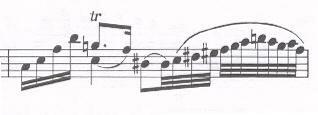

I started the c minor Allemande, but it was quickly determined that the music felt too unstructured from a dance perspective. Similarly, the D Major Allemande, didn’t stand a chance. “It’s lovely, but it wouldn’t work for baroque dance. There are lots of possibilities with modern choreography, however.”
Her tempo for the G Major Courante was approximately 56 beats per minute (quarter notes). The piece starts out very nicely from a dance perspective at this tempo, but it quickly becomes too instrumental with the many eighth notes and sixteenth-note runs and sequences. This notion continues throughout all the suites, except for the C Major Suite. The C Major Courante is composed entirely of eighth notes, a regularity that works very well from a dance perspective, especially if the quarter-note beats are emphasized (i.e. notes inégale).
Since the Courantes sound entirely wrong to my ears at this slow tempo, I did a little more digging into the literature and discovered that Dance and the Music of J.S. Bach calls these movements “Correntes” instead of “Courantes.” They define Correntes:
- “The early eighteenth century Italian corrente is a virtuoso piece for violin or keyboard. It usually consists continuous elaboration in eighth or sixteenth notes over a bass in fast triple meter, with simple textures, slow harmonic rhythm, and phrases of varying lengths. Techniques of elaboration include arpeggiation, sequential repetition, two melodic parts combined into a single line, figures resembling an Alberti bass, and passage-work covering several octaves.” 8
This definition seems to fit most of the “Courantes” in the Bach Cello Suites. The only true Courante, according to Dance and the Music of J.S. Bach is in the c minor Suite. The c minor Courante does sound pretty good at Mansbridge’s tempo. Interestingly, all of the known Bach Cello Suite source manuscripts label these movements as “Courantes,” while the first known published edition (Norblin, 1825) labels them all, including the one in c minor, as “Correntes.”
The second beat should not be consistently emphasized in Sarabandes. According to Mansbridge, this is apparent “in the choreographies for the sarabande, where not all the steps lend themselves to emphasizing the second beat.” Instead, the emphasis should vary from measure to measure, which greatly adds to the musical interest of the piece, i.e. one-TWO-three, one-TWO-three, ONE-two-three, ONE-two-three, or however the music suggests it. This should become clear when one looks at Bach’s Sarabandes in the Cello Suites. Emphasizing the second beat in each measure would sound a little odd.
Interestingly, the 1825 Norblin edition calls the C Major and E-flat Major Bourrées “Loures,” which none of the manuscripts do, nor does Dance and the Music of J.S. Bach. My music dictionary describes the loure as “a 17th dance … in moderate 6/4 time and with dotted rhythms leaning heavily on the strong beats,” 9 which doesn’t seem to fit the bourrées in the cello suites.


- “The most distinctive feature of this characteristically French dance is its graceful lilt, produced by the almost constant use of the “sautillant” figure: [dotted eighth, sixteenth, eight, see Example 6].” 10

- “Bach wrote these amazing works in the early 18th century, so he was just very, very innovative. It’s fascinating what he did with the forms. I can imagine Bach sitting down and saying, for example, ‘That’s an allemande; now I’m going to make this an allemande too! I’m going to ignore the rules for writing an allemande and do something completely different. That’s how his music sounds to me. I also think that Bach’s Cello Suites are much more complicated than the Baroque music that was specifically written for dance, and that the tempos should be approached with this in mind.”
The question we must ask ourselves is whether this new understanding of Baroque dance is going to change how we play these Suites? Do we play the Courantes like true Courantes (i.e. slower) or do we play them faster, like Correntes? Do we play Sarabandes much faster, forcing those beautiful rolling chords to be more ‘in time’? Or do we continue to play them in a more ponderous tempo? Do we continue to infuse the Suites with gut-wrenching emotion, or do we remain somewhat distant, allowing ‘Reason’ to rule over our ‘Passions.’ I’ll leave these questions to you.
2. Louis Pecour, Recueil de Danses and La Nouvelle Galliarde, (Paris, 1700), Gregg International Publishers Limited, London, 1970, p. 47.
3. ‘The Art of Dancing’ explained by reading and figures; whereby the manner of performing the steps is made easy by a new and familiar method: being the original work, first designed in the year 1724, and now published by Kellom Tomlinson, dancing master….London: the author, 1735.
4. Ibid.
5. Statement made in Truls Mørk’s 1999 Internet Cello Society Featured Artist Interview with Tim Janof.
6. Meredith Little and Natalie Jenne, Dance and the Music of J.S. Bach, Indiana University Press, Bloomington, 1991, p. 34.
7. Ibid. p. 115.
8. Ibid. p. 128.
9. Don Michael Randel, Harvard Concise Dictionary of Music, Belknap Press of Harvard University Press, Cambridge, 1978, p. 281.
10. Meredith Little and Natalie Jenne, Dance and the Music of J.S. Bach, Indiana University Press, Bloomington, 1991, p. 145.
11. Ibid. p. 159-160.
12. Ibid. p. 164.
11/02/02
Subjects: Historical, Repertoire
